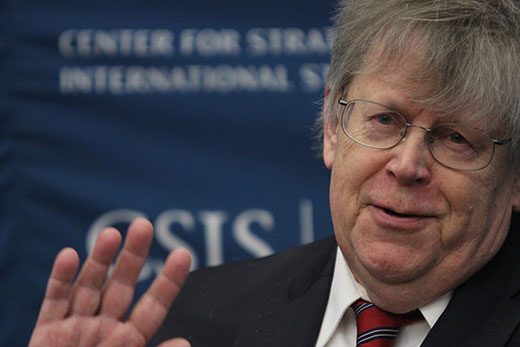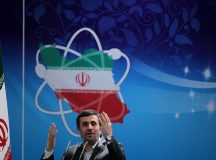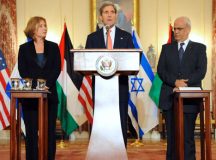Amid the fanfare about the interim agreement reached in Geneva in November 2013 over Iran’s nuclear programme – the first time in 34 years that the Tehran regime and the United States reached a formal understanding – one critical aspect stood out: the true intentions of Iran’s leaders remain as disquietingly unclear now as they were when the existence of the nuclear programme was first revealed in 2002.
For Dr. Olli Heinonen, a Finnish national who spent almost three decades with the Vienna-based International Atomic Energy Agency (IAEA), including a long stint as Deputy Director General, and who is now a Senior Fellow at Harvard University’s Belfer Center for Science and International Security, any optimism about the deal is tempered by the understanding that weaponisation of the nuclear programme remains a realistic prospect. An additional worry, Heinonen told me during a wide-ranging interview, is that the Iranian President Hassan Rouhani, who has emerged as the key interlocutor of the so-called P5+1 (the five members of the UN Security Council, along with Germany), is not someone who can be regarded as the final authority when it comes to Iran’s internal conflicts over the nuclear issue. ‘Do we know the person, and are we talking with him?’ Heinonen asked rhetorically when I put it to him that Western negotiating efforts might not be directed towards the right elements of the Iranian leadership. ‘Most likely not. So there will be very few people who know all the aspects of this programme, and how far it’s gone, and what is the true purpose.’
Why scepticism persists
The nagging sense that the unknown aspects of the nuclear programme will eventually wreck any deal has overshadowed the international debate over the Joint Action Plan (as the agreement reached in Geneva is called). That plan should not be understood as a final agreement; it is an interim step, whereby Iran will receive sanctions relief over a six month period in exchange for freezing certain critical aspects of its nuclear programme, along the road to a fully negotiated outcome. This includes strict curbs upon the enrichment of uranium, discontinuing the development of installations like the enrichment facility at Natanz, the heavy water reactor at Arak, and the enrichment facility at Fordow (a location that was exposed by Western intelligence services in 2009, much to the chagrin of the Iranian leadership), as well as strengthened monitoring and verification under the auspices of the IAEA.
As the initial details of the Joint Action Plan surfaced, critics quickly scorned its apparent jettisoning of negotiating principles previously regarded as sacrosanct – most notably the insistence, enshrined in successive UN Security Council resolutions, that Iran end all of its enrichment activities. In a briefing paper published in December 2013, Heinonen – who, through his former role as a senior IAEA official, is one of the few individuals based in the West with a long track record of dealing with Iran’s leaders – recalled that when President Rouhani had served as a nuclear negotiator 10 years earlier, he boasted of how he had used talks with Western powers to ‘buy time to advance Iran’s programme.’ With doubts surrounding how the Joint Action Plan will be implemented, because of clashing interpretations between the Americans and the Iranians over its substance, Heinonen observed that ‘History appears to be repeating itself. Rather than implementing the deal in good faith, Iran is playing games with it, manipulating the Joint Plan of Action to alter to Tehran’s advantage both the circumstances on the ground and the terms of the deal itself.’
Ultimately, neither party was prepared to risk the ignominy of having the agreement unravel, and agreed on 20 January 2014 as the date to begin the implementation of the Joint Action Plan. But wrangling over implementation provided the Iranian regime with a strategic boost. Speaking at the height of the implementation dispute, Heinonen pointed out that a ‘start date of late January will apparently leave Iran’s uranium and plutonium production programmes significantly closer to breakout capacity than if the Joint Plan of Action had been implemented on 24 November [2013].’ Moreover, questions remain as to whether the agreement will survive the six month period from 20 January 2014. ‘We don’t trust them,’ Iranian Deputy Foreign Minister Abbas Araqchi candidly said of the P5+1 in an interview with state media, adding that Iran was ready to end compliance with the deal in the event that its partners did not live up to their commitments.
The West knows more than we think
Yet, however bleak the prospects of a final agreement arising from the Joint Action Plan may seem, Heinonen’s concerns about the slipperiness of the Iranian leadership are offset against the realisation that Western powers know much more about the nuclear programme than is generally appreciated. ‘People very often talk about the laptop,’ he told me, referring to the controversial unveiling by American intelligence of a laptop computer taken from the Iranians that supposedly contained evidence of designs for nuclear warheads. ‘But there is a lot of other hard evidence which is reflected in the IAEA reports or other procurement information.’ Heinonen stressed that the IAEA’s concerns about the military dimension of the nuclear programme pre-date the publication of the agency’s widely-cited November 2011 report, in which ‘the possible existence in Iran of undisclosed nuclear related activities involving military related organisations, including activities related to the development of a nuclear payload for a missile’ was highlighted. In particular, he pointed to the IAEA’s landmark report of November 2004, an extraordinarily detailed account that disclosed a large number of Iranian reporting failures, such as the use of imported uranium hexafluoride – which produces fuel for nuclear weapons – in the testing of centrifuges, as well as the design details of its enrichment facilities.
Significantly, the very same decade-old report mentioned that ‘Dr. Rouhani’ had agreed to provide ‘a full disclosure of Iran’s past and present nuclear activities.’ Following the receipt of a letter from the Iranian government, the IAEA guardedly stated that it was ‘still in the process of assessing some of the information provided in that letter and in subsequent clarifications.’ That assessment, clearly, is still continuing. Still, as Heinonen recounted the revelations of 2004, as well as those in subsequent IAEA reports, there was a discernible air of pride in his voice. Extracting the correct information is, he said, a painstaking process that requires patience. ‘I have been dealing with the Iranians for more than 10 years,’ he reminded me, before adding that progress doesn’t ‘come overnight.’ The mindset of a negotiator, he explained, should lean towards the ‘scientific and technical and not get into any of the political debates.’ Above all, it means taking seriously, within the framework of direct talks with officials of its nuclear programme, Iran’s assurances that its intentions are civilian in nature; indeed, the Joint Action Plan expressly states that Iran will not ‘seek or develop nuclear weapons.’ Said Heinonen: ‘One of the most important things is to discuss what will be the Iranian civilian nuclear programme, what will be the scope and the needs.’ If those discussions are to be meaningful, he said, ‘this military dimension would have to be solved.’
In that regard, Heinonen added, it is worth remembering that in the history of nuclear weapons development, those working on the civilian side of a nuclear programme often have no idea of the parallel military uses their work is put to. For example, the weaponisation dimension of Saddam Hussein’s nuclear programme in Iraq, said Heinonen, was assigned to ‘a special project, PC3, or Petrochemical Project 3.’ Similarly, the Apartheid regime in South Africa was also careful to separate the military and civilian wings of its nuclear programme. There were scientists on the civilian side who knew how to enrich uranium, Heinonen said, ‘but it was an entirely different group of people who took over that uranium, made it into a nuclear weapon, and these two organisations had nothing to do with each other. So [the enriched uranium] was just put on a lorry or a pick-up truck, and then the other guy gets it. The one who produced it, he probably had an educated guess where it goes, but he didn’t really know.’
In the Iranian context, these operational ambiguities have stoked related fears about the existence of additional concealed nuclear sites. ‘Everything that happens here is at a known, declared place,’ Heinonen told me frankly. ‘There is no assurance that there isn’t another enrichment plant under construction somewhere else.’ Similar anxieties exist over Iran’s ‘breakout’ time – the point at which it is able to produce sufficient weapons grade uranium for a nuclear weapon. Some analysts, such as the Washington DC-based Institute for Science and International Security, a body with which Heinonen is closely affiliated, believe ‘breakout’ could occur by the middle of this year. However, Heinonen and others have emphasised that there is an additional step to weaponisation, which involves the development of nuclear weapons components. As he clarified during a recent conference call for American journalists, ‘if you want to have a nuclear weapon which you deliver, for example with a missile, that part of the programme probably is far away, maybe a year from now.’
Red lines and risk assessment
Heinonen elaborated on this last point during his conversation with me, when addressing the lack of consensus among Western leaders about what constitutes the Iranian nuclear programme’s red line. ‘You have to keep in mind that a missile is not the only delivery vehicle for a nuclear weapon,’ he said. ‘But President Obama says the red line that he wants to prevent is a nuclear weapon integrated with a missile. That’s why he talks about a period which is beyond one year, that it will take at least one year before Iran can do it.’ For other leaders, the red line is in a different location. ‘Some people say that as soon as [the Iranians] are able to produce in a short period of time highly enriched uranium, that’s the red line,’ said Heinonen, pointing out that this position is associated with, among others, Israeli Prime Minister Benjamin Netanyahu. More broadly, he continued, differing visions and interpretations have confounded efforts to create a consensus about what Iran has achieved thus far, where its nuclear programme is headed, and what measures Western powers need to take in response. ‘In the US and Iran, there are a lot of people who are against this agreement,’ said Heinonen. ‘On top of that, you have the P5+1, six countries, not all of them involved with the same intensity, but they have their own ideas. There are differences, different visions maybe even about the associated risks. One party may take more risks than another party.’ Credible assessment of risk stems, of course, from empirical knowledge of Iran’s nuclear activities, along with the historical awareness that so much of the nuclear programme’s development was clandestine in character. At the same time, much of the debate in the US over the last few months suggests that an alternative calculus is now in play, one that regards Iran more as a partner than as an adversary, particularly when it comes to confronting Sunni Islamist terror organisations in the region. The Obama administration’s angry reaction to pressure from Congress to retain tough sanctions on Tehran indicates that it no longer regards an Iranian regime armed with nuclear weapons as the worst of all possible threats that might emanate from the Middle East. Moreover, talk of pre-emptive military action – the most radical step contained within the ‘all options on the table’ approach adhered to by Presidents Bush and Obama – has all but disappeared from the current chatter in Washington. As long as the Joint Action Plan is being implemented, Heinonen said, ‘military action is much more difficult.’ And as the US and its allies deliberate over what Heinonen described as the ‘hiccups’ that inevitably come with implementation, all the signals are that caution will be the guiding principle of the P5+1. No Western leader has yet been brazen enough to openly declare that we can live with a weaponised Iran, but that thought is no longer as heretical as it might have seemed even one year ago.






































Do you recognize what a hypocrite Israel sounds like when it unilaterally focuses on Iran’s nuclear program without itself signing the NPT or having its facilities open to IAEA inspection?